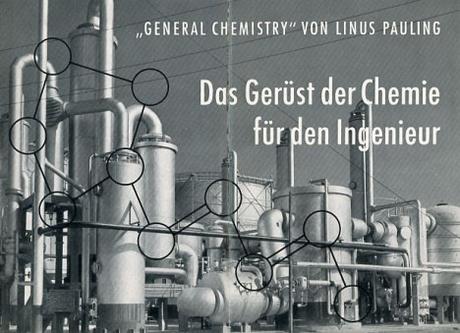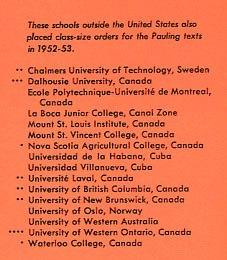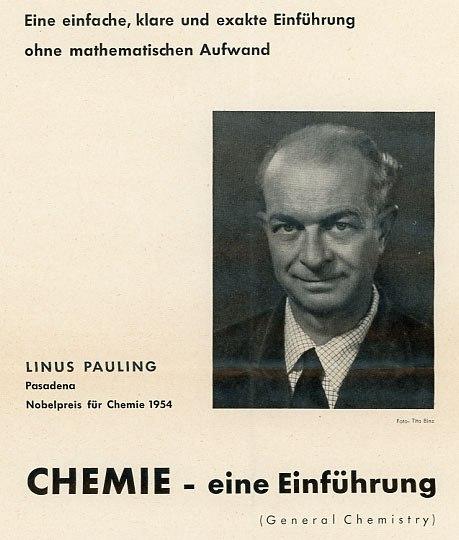
[An examination of General Chemistry, published by Linus Pauling seventy years ago. This is part 5 of 7.]
General Chemistry has been translated into twelve languages, and most of the foreign editions of the text were published in the interim between the release of the U.S. second and third editions, 1953-1970. As Linus Pauling’s book gained increasing recognition stateside, more and more translation requests began to pour in. Pauling himself bore only limited responsibility for responding to these requests; this was publisher William Freeman’s area of expertise, and he had developed strict guidelines which translators were obligated to follow.
In order for a foreign translation to be formally recognized by Freeman and Co., a translator had to submit a proposal to a publisher in their own country, who then contacted Freeman and Co. for approval. Once William Freeman had obtained Pauling’s permission to go ahead, he made an offer to the overseas publisher, negotiating royalty rates, the price of the book, and any considerations necessitated by differences in copyright law from country to country. Once Freeman and the overseas publisher agreed to terms, the two parties drew up a contract. Only then was the translator free to begin with their work.
Once they moved out of Freeman’s purview, these editions took on lives of their own, and results certainly varied. Many U.S. reviewers, for instance, were dismayed to learn that General Chemistry served as a high school text in several European countries, as well as in Japan. Additionally, German institutions tended not to use their translation as a textbook, except in rare cases. In providing an explanation for this phenomenon, the German translator, Friedrich Helfferich, explained that Chemie: eine Einführung
owes its success to its appeal to the general interested public, e.g., the engineer, physician, psychologist, etc., wanting to obtain a modern concept of chemistry; to the boy in his last year of high school who plays with the idea of taking up chemistry; even to the philosopher.
Pauling and Freeman, while disgruntled by the evident differences between American and European education standards, were nonetheless proud of the book’s wide adoption.

The Spanish edition, which was the easiest translation to complete, was also the first foreign version of General Chemistry to appear, hitting the market in 1949, just two years after the U.S. first edition’s introduction to stateside readers. Fernandez Alonso, a professor from Universidad de Valencia in Spain, completed the work in only six months. Pauling was so pleased with this edition that he offered Alonso the job of translating his other text, College Chemistry, as well as subsequent editions of General Chemistry.
On the other hand, the German translation presented significant challenges. For one, Freeman and Co. encountered initial difficulties in determining whether there was even a market for the book, given the tenuous post-war relationship between the U.S. and a divided Germany. Further, when Chemie Verlag, a German publishing house focused on science, approached Freeman and Pauling for the rights to translate and produce a German edition, Freeman was already deep into negotiations with a different German option.
Pauling felt so strongly about Chemie Verlag, however, that he wrote to their director to make his preferences clear, encouraging him to match the offer being made by their competitor. Two months later, Freeman accepted Chemie Verlag’s offer and Friederich Helfferich began translating. While the work moved smoothly from there, all of the uncertainties that had preceded it meant that the German edition was not completed until 1958 and was based on the second U.S. edition.
The German translation was also the one in which Pauling became the most involved. Proficient in German from his upbringing, his university studies and his travels abroad, Pauling edited almost all of the proofs and often expressed his opinions about which German words would more appropriately address the concepts presented in his book. When he at last received the completed German translation, Pauling immediately wrote back to express his satisfaction with it and his gratitude to Helfferich.
In the years following, Helfferich took it upon himself to continue to update the material such that, just prior to the release of the third U.S. edition, Chemie Verlag had already published four editions of Chemie: eine Einführung. Part of this productivity was surely due to Helfferich’s self-directed industry, but perhaps more important was the lack of distinction made by the German publishers between a reprint (correcting technical errors) and a revision (a new edition). As it turned out, Helferrich had done some of both without a great deal of guidance from Pauling.
Thinking about how best to approach a translation of Pauling’s third edition, which was still in the works, Helfferich suggested two options. Option 1 was to discard all changes that he had made on his own to “update” the German editions to reflect recent scientific advances. Option 2 was to use the new edition as an opportunity to unify the changes that he had made with those that Pauling was considering for the U.S. edition.
Helfferich argued that, on the plus side, the latter option would produce a German edition that was even further customized to the German readership and, as a result, likely to sell very well. This option, however, would also require significant collaboration between author and translator, a commitment that turned out to be a deal-breaker for Pauling.
Ultimately, Pauling requested that Helfferich limit his own contributions to a two-chapter minimum. He also asked that Helfferich remove his name from the title page, so as to make it abundantly clear that Pauling was the sole author of the book. Helfferich subsequently decided to postpone a German 5th edition until Pauling had released the U.S. third edition, which he then translated in a more orthodox fashion.

The international reach of General Chemistry was truly impressive. The first edition was translated into Spanish, French, Italian, Japanese, and Swedish. The second edition was translated, once more, into these five languages as well as German, Polish, Gujarati, and Portuguese. Russian, Romanian and Hebrew editions also eventually came to pass.
As the international profile of the book grew and grew, Freeman and Co. ran into a few problems with freelance translators. The most pressing issue that the publishing house faced however, were differences in royalty laws from country to country. Even in the U.K., where Pauling’s book didn’t require linguistic translation, it was nearly impossible to find a publishing company that could offer Pauling a royalty rate comparable to Freeman’s.
Perhaps most notably, for the Japanese edition, Pauling was compelled to collect his royalties in Japanese currency and then bring the yen back to the United States for exchange into U.S. dollars. It was in Japan, however, that the book was most successful internationally – sales were still increasing more than ten years after its release – a fact which no doubt contributed to Pauling’s close relationship with that country, including eight visits during his lifetime.
Advertisements &b; &b;